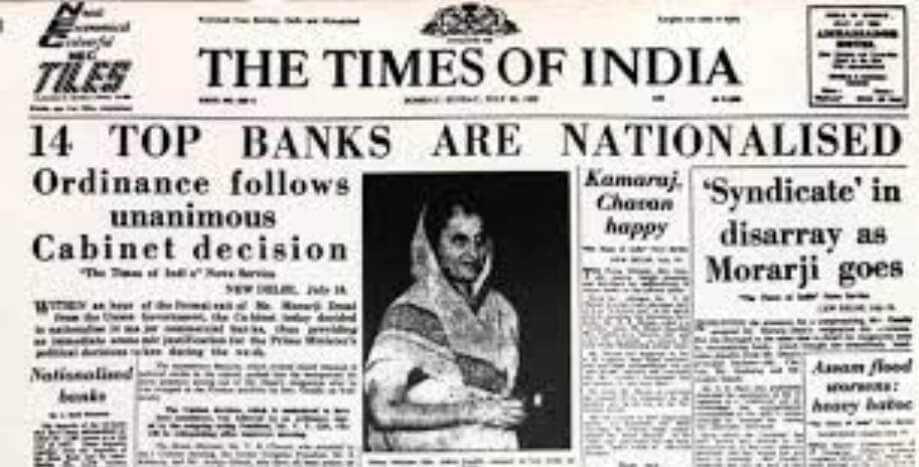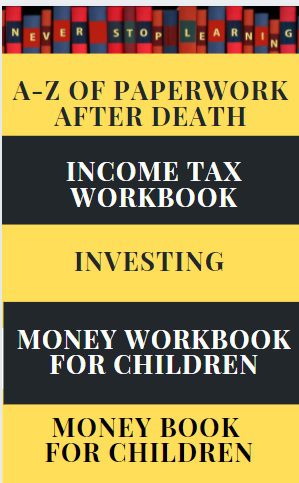14 largest commercial banks that accounted for 85% of bank deposits in the country then were nationalised in the midnight of July 19, 1969. Later in 1980, six more banks were nationalised. Why were these banks nationalised? Was nationalisation of banks good or bad?

Nationalization of Banks 1969
Table of Contents
What is Nationalization?
Nationalization, or nationalisation, is the process of transforming private assets into public assets by bringing them under the public ownership of a national government or state. Nationalization usually refers to private assets or assets owned by lower levels of government, such as municipalities, being transferred to the state.
The opposites of nationalization are privatization and demutualization
For example, In 1951, railway companies like Great India Peninsular Railway, Bengal Railway, etc, were nationalised to form Indian Railways.
Why were banks nationalised?
Indira Gandhi told the Lok Sabha on 29 July 1969 that the “purpose of nationalization is to promote rapid growth in agriculture, small industries and export, to encourage new entrepreneurs and to develop all backward areas”. This was part of the overall political strategy to squeeze big business houses that backed her opponents, as well as build a new political base.
Collapse of private Banks
Before Indira Gandhi nationalised banks, only State Bank of India was a public sector undertaking, having been nationalised in 1955.
The SBI nationalisation had happened in the backdrop of private banks going bankrupt at an alarming rate. More than 360 banks had failed between 1947 and 1955 — the rate of collapse was 40 banks a year. Banks were failing largely due to speculative financial activities
The trend continued through the 1950s and the first half of 1960s. In 1960, when Palai Central Bank and Lakshmi Commercial Bank collapsed, pushed by finance minister Morarji Desai, the RBI brought down the number of banks from 328 in 1960 to 94 by 1965 through closures and mergers.
The collapse of banks was causing distress among people, who were losing their hard-earned money in the absence of a strong government support and legislative protection to their money.
Politics
Those were different times for Congress. Indira Gandhi political authority was invariably questioned by those who were colleagues of her father, Jawaharlal Nehru. A group of leaders led by K Kamraj and Morarji Desai, known as the Syndicate, controlled the party and Indira Gandhi was being forced to toe their line.
The death of President Zakir Hussain saw both sides taking off their gloves. The Syndicate put up Neelam Sanjeeva Reddy as its presidential candidate to challenge Indira Gandhi, who favoured VV Giri.
Collapse of banks was causing loss of trust in people. The banks were more interested in extending credit for trade.The banks were not giving credit to agriculture and not enough to industry.
Indira Gandhi saw a rare chance to become people’s hero at a time when she was being challenged within the Congress party.
There was politics as Banking was necessary for the development and to extend the reach of government programmes. But there were other reasons too. The government issued the Banking Companies (Acquisition and Transfer of Undertakings) Ordinance, 1969, which empowered it to nationalise banks.
- Access to banking services was available to only a handful of rich and middle-class urban households. But the government felt that banking had to spread, giving access to both the rich and the poor.
- Sectors such as exports, agriculture, and the small-scale industries were lagging behind.
- The moneylenders used to exploit the poor people in India.
- Many banks collapsed post World War II as they were financing speculative activities
- RBI, a relatively young banking regulator then, was finding it hard to supervise some 300 banks, most of which were into trade finance and reluctant to support industry and agriculture.
- In 1960, when Palai Central Bank and Lakshmi Commercial Bank collapsed, pushed by finance minister Morarji Desai, the RBI brought down the number of banks from 328 in 1960 to 94 by 1965 through closures and mergers. Post nationalisation, the government forced a merger only once – that of New Bank of India with Punjab National Bank in 1993. Now, the consolidation drive has been in full force. After ensuring merger of SBI’s associates with the parent, the government has merged two relatively small banks with Bank of Baroda and more such mergers could be on the cards.
The second volume of the official history of the Reserve Bank of India describes bank nationalization as the single-most-important economic policy decision taken by any government after 1947. Central bank historians say that in terms of the impact, even the economic reforms of 1991 pale in comparison.
In August 7, 1969 Indira Gandhi outlined the objectives of bank nationalisation in a radio address. She said, “Nationalisation is necessary for the speedy achievement of these objectives.” These were,
- removing control of the few on banking system,
- providing adequate credit for agriculture, small industry and exports,
- giving a professional bent to bank management and
- encouraging a new class of entrepreneurs.
Also, for a rural section of India, the regional rural banks (RRBs) were formed. The objective was to serve large masses of the unreserved rural population.
Further, the specific requirements of sectors like foreign trade, housing, and agriculture were met. This was met by establishing NABARD, NHB, SIDBI, and EXIM.
What was India like in 1969?
India was buffeted by economic as well as political shocks.
- There were two wars—with China in 1962 and Pakistan in 1965—that put immense pressure on public finances.
- Two successive years of drought had not only led to food shortages but also compromised national security because of the dependence on American food shipments to keep hunger at bay.
- Fiscal retrenchment through a three-year plan holiday had hurt aggregate demand as public investment was cut.
- The 1966 devaluation of the rupee was an economic success, but also a lightning rod for political anger.
- The Congress party had already suffered electoral setbacks in the 1967 elections. It was headed for a split.
- The Naxalites were growing in strength.
However, the devaluation had helped improve the balance of payments while the Green Revolution began to ease the food constraints.
Comparing Banking in 1969 and 2019
- Then, there were 73 commercial banks (excluding regional rural banks); now the figure is 91.
- The number of bank branches have grown phenomenally – from 8,262 to 1,41,756.
- What is particularly important is the share of rural branches, which was just about 22 per cent in 1969 and has gone up to more than 35 per cent now – from 1,832 to 50,081.
- The share of semi-urban branches dropped from 40 per cent to 27.5 per cent (3,223 to 9,063)
- while there has not been any significant change in the share of urban (1,447 to 25,498) and metropolitan branches (1,661 to 27,114).
The size of the banking industry has grown many times in the past five decades. Aggregate deposits have risen from a meagre Rs 4,646 crore to close to Rs125 trillion and bank credit, from Rs3,599 crore to Rs 96.5 trillion.
For the record, till the 1990s, the PSBs’ assets grew at a pace of around 4 per cent in sync with the average growth rate of the Indian economy. That got changed dramatically in the first decade of this century (the credit growth was three times or more the growth of India’s GDP between 2006 and 2008) but the pace slowed considerably and many of them actually have been shrinking their balance sheets since 2015 after being forced to expose their weak underbelly – a pile of bad assets.
How did the government manage to take over private banks?
Bank nationalisation was not publicly debated. Then-Prime Minister Indira Gandhi in her address at the Bangalore session of Indian National Congress on July 12, 1969, forcefully pitched for it in a paper entitled Stray thoughts on Bank Nationalization.
Indira Gandhi needed to get bank nationalisation done in next seven days as stand-in President VV Giri was to step down on July 20, and Indira Gandhi was not sure if Giri would win the presidential election. The Syndicate candidate was not expected to approve of Indira Gandhi’s move.
A team comprising Indira Gandhi’s principal secretary PN Haskar, one of RBI deputy governors A Bakshi and DN Ghosh, a bureaucrat got to work almost secretly. Neither IG Patel, then economic affairs secretary, nor LK Jha, then RBI governor, knew of the plan.
A draft Ordinance was prepared on July 18 and the next day it was passed by the cabinet at 5 pm. President Giri promulgated it and Indira Gandhi addressed the nation at 8.30 pm. It had come as a shocker to the business community, as the RBI noted. But the people were happy and Indira Gandhi won the perception battle which helped her win 1971 Lok Sabha polls and also 1972 assembly polls in many states.
Incidentally, Narendra Modi’s demonetisation announcement in an unscheduled televised national address was made at 8.15 pm and came as a shocker to the business community but hugely welcomed by the general public. The subsequent state polls in Uttar Pradesh and other states stood testimony to that.
The order would apply from the midnight of July 19, 1969, on 14 largest commercial banks that accounted for 85% of bank deposits in the country then. Within two weeks of the issue of the ordinance, the Parliament passed the Banking Companies (Acquisition and Transfer of Undertaking) Bill, and it received presidential approval on 9 August 1969.
Later in 1980, it nationalised six more banks.
Which banks were nationalised and when?
The following banks were nationalised in 1969:
- Allahabad Bank
- Bank of Baroda
- Bank of India
- Bank of Maharashtra
- Central Bank of India
- Canara Bank
- Dena Bank
- Indian Bank
- Indian Overseas Bank
- Punjab National Bank
- Syndicate Bank
- UCO Bank
- Union Bank
- United Bank of India
A second round of nationalisations of six more commercial banks followed in 1980. The stated reason for the nationalisation was to give the government more control of credit delivery. With the second round of nationalisations, the Government of India controlled around 91% of the banking business of India.
The following banks were nationalised in 1980:
- Punjab and Sind Bank
- Vijaya Bank
- Oriental Bank of India
- Corporate Bank
- Andhra Bank
- New Bank of India
Later on, in the year 1993, the government merged New Bank of India with Punjab National Bank.It was the only merger between nationalised banks and resulted in the reduction of the number of nationalised banks from 20 to 19.
What was the impact of Nationalisation of Banks?
The impact of bank nationalization can be thought about in terms of three core areas: deposits, lending and interest rates.
The one positive impact of bank nationalization was that financial savings rose as lenders opened new branches in areas that were unbanked. Gross domestic savings almost doubled as a percentage of national income in the 1970s.
What is the current status of Nationalized Banks?
Although the government succeeded partially in meeting its goal of implementing its development agenda through the banking system, many in India still lack access to formal finance.
The Pradhan Mantri Jan Dhan Yojana, the world’s most expansive financial inclusion drive, has 36.06 crore new depositors. The public sector banks’ contribution to this is 28.65 crore in contrast to private banks’ 1.25 crore (the rest is done by the regional rural banks). The government-owned banks generally do a good job of what is mandated by their majority owner but most are failed business enterprises.
The banks also faced issues like
Competition: They have to compete with new private banks that came up 25 years later with state-of-the-art technology.Several state-run banks have trailed rivals in technology.
Bad Assets: the project finance institutions were wound up and the public sector banks, which did not know much beyond giving working capital loans, had no choice but to extend long-term financing to Indian corporations. That sowed the seeds of bad assets.
Government Control: the government ceded the majority ownership but not the control. It continues to appoint the CEOs, plays a critical role in the constitution of the boards and uses the infrastructure of the industry at times for things remotely connected to banking. It also does not pay the bankers market-related compensation.
Although government control has reduced since liberalisation, the lenders are saddled with majority of bad loans and starved of capital. The government has considered a reduction of equity ownership and capital infusion to strengthen the public banking system.
Bank nationalization succeeded in specific areas such as financial deepening because of the rapid spread of branches, but it eventually did more harm than good.
Trick to Remember nationalization date of Banks
2) VIJAYA BANK (VIJAYA)
3) ORIENTAL BANK OF COMMERCE (COMMERCE)
4) CORPORATION BANK (CORPORATE)
5) ANDHARA BANK (ANDHARA PARDESH)
Questions on Nationalization of Banks
How many banks were first nationalised?
(1).10 (2) 12 (3) 14 (4) 16 (5) 24 5.
When was the second phase of nationalisation done?
(1) 9th July, 1969 (2) 10th July, 1968 (3) 16th August, 1985 (4) 15th April, 1980 (5) None of these
How many banks were there in the second phase of nationalisation?
(1) 4 (2) 5 (3) 6 (4) 7 (5) 9
The second phase of bank nationalization took place in 1980 during the prime ministerial tenure of Indira Gandhi. Which bank was nationalised in this phase
(1) Indian Overseas Bank (2) Central Bank of India (3) Canara Bank (4) Vijaya Bank (5) Dena Bank
Related Articles:




What does it mean to previous shareholders of the nationalized bank? Would they be paid the value?